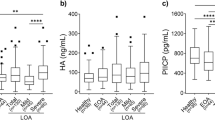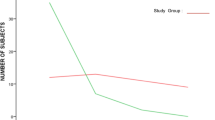Abstract
Aggrecan and cartilage oligomeric matrix protein (COMP) which are important degradation products of articular cartilage may be promising diagnostic markers in serum and/or synovial fluid for diagnosis of knee osteoarthritis (OA). Our objective was to measure serum and synovial fluid levels of aggrecan and COMP in patients with OA of the knee joint to find out if they could be of diagnostic value in OA and if their levels correlate with the clinical and radiological manifestations of the disease. Sixty-six patients suffering from primary knee OA with effusion (26 males and 40 females) were studied. Twenty individuals (six males and 14 females) with recent traumatic knee effusion matched for age and sex were chosen to serve as a control group. All subjects had thorough clinical and radiological (X-ray and MRI) evaluation. Aggrecan and COMP in serum and synovial fluid were measured by ELISA. Serum and synovial fluid aggrecan and COMP levels were significantly higher than the control. Serum and synovial fluid aggrecan and COMP levels were positively correlated with age, body mass index, disease duration, plain X-ray and MRI scores. In OA, serum and synovial fluid aggrecan and COMP levels are elevated and represent useful markers in the diagnosis. Moreover, these elevated levels positively correlated with radiological joint damage but not with clinical disease parameters. These markers have the potential to be used for monitoring articular cartilage destruction and response to different therapeutic modalities.
Similar content being viewed by others
References
Kuettner K and Goldberg V (1995). Osteoarthritic disorders. In: Rosemont IL (ed). Illinois: American Academy of Orthopedic Surgeons. pp 247–60.
Cucchiarini M,Thurn T, Weimer A, Kohn D, Terwilliger EF, Madry H.(2006). Restoration of the extracellular matrix in human osteoarthritic articular cartilage by overexpression of the transcription factor SOX9. Arthritis Rheum; 56(1):158–67
Neustadt DH (2006). Intra-articular injections for osteoarthritis of the knee. Cleve Clin J Med; 73(10):897–8.
Frederick W and Nancy L (2002). The long-term outcome of osteoarthritis: Rates and predictors of joint space narrowing in symptomatic patients with knee osteoarthritis; J Rheumatol. 29(1):139–46
Anita W, Stephen S and Judith S (2002). The determinants of change in tibial cartilage volume in osteoarthritis knees. Arthritis Rheum; 46 (8): 2065–72.
Schmidt B, Gavenis K and Kippels M (2002). New potential markers for cartilage degradation of the knee joint. Scand J Rheumatol; 31: 151–7.
Altman R, Asch E and Bloch D (1986). Development of criteria for the classification and reporting of osteoarthritis. Arthritis Rheum; 29: 1039–49.
Huskisson E (1982). Measurement of pain. J Rheumatol; 9: 678–9.
Gunn J (1976): Clinical examination of the knee joint. Bone joint Surg; 5: 10–15
Jones A, Hokinsm V and Patizick M (1992). Evaluation of a method for clinically assessing osteoarthritis of the knee. Ann Rheum Dis; 51: 243–5.
Aichroth P, Freeman M and Samilli L (1978). Deformities of the knee joint. J Bone Joint Surg Am; 50: 60–75.
Lequesne G, Mery C and Samson M (1987). Indexes of severity for osteoarthritis of the hip and knee. Validation value in comparison with other assessment tests. Scand J Rheumatol; 65 (suppl.): 85–9.
Bellamy N, Buchanan W and Goldsmith C (1995). A health status instrument for measuring clinically important patient relevant outcomes to antirheumatic drug therapy in patients with osteoarthritis of the hip or knee. J Rheumatol; 15: 1833–40.
Neidhart M, Hauser N , Paulsson M,DiCesare P,Michel B and Hauselmann H (1997). Small fragments of cartilage oligomeric matrix protein in synovial fluid and serum as markers for cartilage degradation. Br J Rheumatol; 36: 1151–60.
Seliem H, Afiefy T and Radwan H (1998). Value of MRI in detection of disease progression in knee osteoarthritis. Egypt Rheumatol Rehab; 25(4): 531–8.
Duncan S and Owen J (1997). Aspiration and injection of joints and soft tissues. In: Kelly W, Harris E, Ruddy S and Seldge C (eds): Textbook of Rheumatology, 5th edn. Philadelphia: Saunders. pp 591–7.
Lohmander S, Lark M, Dahibergle L, WalakovitsL and Roos H (1992). Cartilage matrix metabolism in osteoarthritis : Markers in synovial fluid, serum and urine.Clin Biochem; 25:167–74.
Garnero P, Piperno M and Gineyts E (2001). Cross sectional evaluation of biochemical markers of bone, cartilage, and synovial tissue metabolism in patients with knee osteoarthritis: Relations with disease activity and joint damage. Ann Rheum Dis; 60: 619–26.
Peterfy G (2002). Imaging of the disease process. Current Opinion in Rheum; 14 (5): 590–6.
Bruyere O, Collette J, Kothari M, Zaim S, White D, Genant H, Peterfy C, Burlet N, Ethgtn D, Montague T, Dabrowski C and Reginster GY (2006). Osteoarthritis, magnetic resonance imagining and biochemical markers: A one year prospective study. Ann Rheum Dis; 65 (8): 1050–54.
Lohmander L, Inoescu M and Jugessur H (1999). Changes in joint cartilage aggrecan after knee injury and in osteoarthritis. Arthritis Rheum; 42: 534–44.
Otterness G, Swindell C and Zimmerer A (2000). Analysis of 14 molecular markers for monitoring osteoarthritis. Osteoarthritis Cart; 8 (3): 180–5.
Larsson S, Lohmander LS, Struglics A. (2009). Synovial fluid level of aggrecan ARGS fragments is a more sensitive marker of joint disease than glycosaminoglycan or aggrecan levels: a cross-sectional study. Arthritis Res Ther; 11(3):R92.
Cawston T, Ellis J and Humm G (1995). IL-1 and 14, oncostatin M in combination promotes the release of collagen fragments from bovine nasal cartilage in culture. Biochem Biophys Res Comm; 215: 377–85.
Clark A, Jordan J and Villim V (1999). Serum cartilage oligomeric matrix protein reflects osteoarthritis presence and severity. Arthritis Rheum; 42: 2356–64.
Villim V, Olejarova M and Kraus B (2002). Serum levels of cartilage oligomeric matrix protein correlate with radiographic progression of knee osteoarthritis. Osteoarthritis Cart; 10:707–13.
Huang K, Wu LD (2008). Aggrecanase and aggrecan degradation in osteoarthritis: a review. J Int Med Res; 36(6):1149–60.
Svetlova MS, Vezikova NN, Romashina VV, Sobanina TS, Pavlov IuL, Chepliukova IA (2008). Cartilage oligomeric matrix protein, a possible marker of synovitis in early knee joint osteoarthrosis. Klin Med (Mosk); 86(11):65–8.
Fuller C, Barr A and Sharif M (2001). Cross sectional comparison of synovial fluid biochemical markers in equine osteoarthritis and the correlation of these markers with articular cartilage damage. Osteoarthritis Cart; 9: 49–55
Bleasel J, Poole R and Heinegard D (1999). Changes in serum cartilage marker levels indicate altered cartilage metabolism in families with osteoarthritis-related type II collagen gene mutation. Arthritis Rheum; 42:39–45.
Wislowska M and Jablonska B (2005). Serum cartilage oligomeric matrix protein (COMP) in rheumatoid arthritis and knee osteoarthritis. Clin Rheumatol; 24(3):278–84
Dragomir A, KrausV and Renner J (2002). Serum cartilage oligomeric matrix protein and clinical signs and symptoms of potential pre-radiographic hip and knee pathology. Osteoarthritis Cart; 10: 687–91.
Belcher C, Yaqub R and Fawthrop F (1997). Synovial fluid chondroitin and keratan sulfate epitopes, glycosaminoglycans, and hyaluronan in arthritic and normal knees. Ann Rheum Dis; 56: 299–307.
Petersson I, Boegard B and Svensson D (1998). Changes in cartilage and bone metabolism identified by serum markers in early osteoarthritis of the knee joint. Br J Rheumatol; 37:46–50.
Conrozier T, Saxne T and Shan F (1998). Serum concentrations of cartilage oligomeric matrix protein and bone sialoprotein in hip osteoarthritis: A one year prospective study. Ann Rheum Dis; 57:527–32.
Lohmander S, Dahlberg L and Eyre D (1998). Longitudinal and cross-sectional variability in markers of joint metabolism in patients with knee pain and articular cartilage abnormalities. Osteoarthritis Cart; 6:351–61.
Saxne T, Geborek P and Mansson B (1995). Knee joint synovial fluid content of aggrecan predicts knee/ hip joint destruction in rheumatoid arthritis. Trans Orthop Res Soc; 20: 344–7.
Sharif M, Saxne T and Shepstone L (1995). Relationship between serum cartilage oligomeric matrix protein levels and disease progression in osteoarthritis of the knee joint. Br J Rheumatol; 34: 306–10.
Otterness I, Weiner E and Swiltldell A (2001). Analysis of 14 molecular markers for monitoring osteoarthritis. Osteoarthritis Cart; 9: 224–31.
Bruyere O, Collette J and Ethgen O (2003). Biochemical markers of bone and cartilage remodeling in prediction of long-term progression of knee osteoarthritis. J Rheumatol; 30: 1043–50.
Campion G, McCrae F and Schnitzer T (1991). Levels of keratan sulfate in the serum and synovial fluid of patients with osteoarthritis of the knee. Arthritis Rheum; 34: 254–9.
Thonar J, Masuda K and Lenz M (1995). Serum markers of systemic disease processes in osteoarthritis. J Rheumatol; 22: 68–70.
Ratcliffe A, Flatow E and Roth N (1996). Biochemical markers in synovial fluid identify early osteoarthritis of the glenohumeral joint. Clin Orthop; 330: 45–53.
Chevalier X (1997). Is a biological marker for osteoarthritis within reach? Rev Rheum Engl Ed; 64(10): 562–77.
Disler G, McCauley R and Kelman G (1996). Fat suppressed three-dimensional spoiled gradient echo MR imaging of hyaline cartilage defects in the knee. AJR; 167: 127–32.
Waldschmidt J, Rilling R and Kajdacsy A (1997). In vitro and in vivo MR imaging of hyaline cartilage: Zonal anatomy, imaging pitfalls, and pathologic conditions. Radiographics; 17: 1392–8.
Villim V, Vytasek R and Olejarova M (2001). Serum cartilage oligomeric matrix protein reflects the presence of clinically diagnosed synovitis in patients with knee osteoarthritis. Osteoarthritis Cart; 9:612–8.
Fragonas E, Mlynarik V and Jellus V (1998). Correlation between biochemical composition and magnetic resonance appearance of articular cartilage. Osteoarthritis Cart; 6(1): 24–32.
Author information
Authors and Affiliations
Corresponding author
Additional information
Author contributions: Mohammed El-Arman designed the research and analyzed the data. G. El-Fayoumi, E. El-Shal, A. El-Ghaweet and Ibrahim El-Boghdady provided the samples and clinical data. Mohammed El-Arman prepared reagents/analytic tools and performed laboratory part and wrote the paper.
Each author certifies that he or she has no commercial associations (e.g., consultancies, stock ownership, equity interest, patent/licensing arrangements, etc.) that might pose a conflict of interest in connection with the submitted article.
Each author certifies that his or her institution has approved the reporting of these cases, that all investigations were conducted in conformity with ethical principles of research, and that informed consent for participating in the study was obtained.
Level of Evidence: Level II Prognostic study. See levels of evidence for a complete description.
Rights and permissions
About this article
Cite this article
El-Arman, M.M., El-Fayoumi, G., El-Shal, E. et al. Aggrecan and Cartilage Oligomeric Matrix Protein in Serum and Synovial Fluid of Patients with Knee Osteoarthritis. HSS Jrnl 6, 171–176 (2010). https://doi.org/10.1007/s11420-010-9157-0
Received:
Accepted:
Published:
Issue Date:
DOI: https://doi.org/10.1007/s11420-010-9157-0




